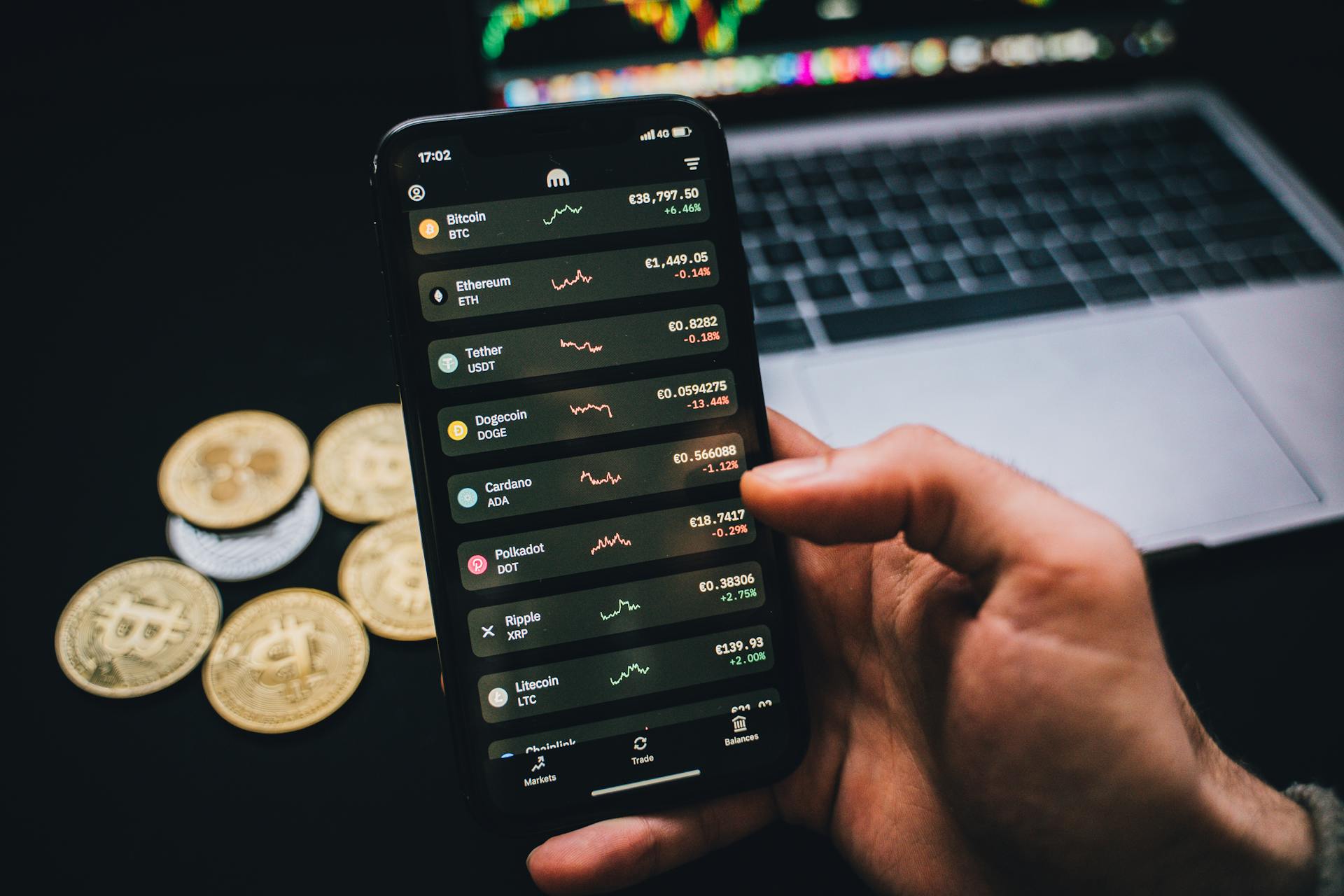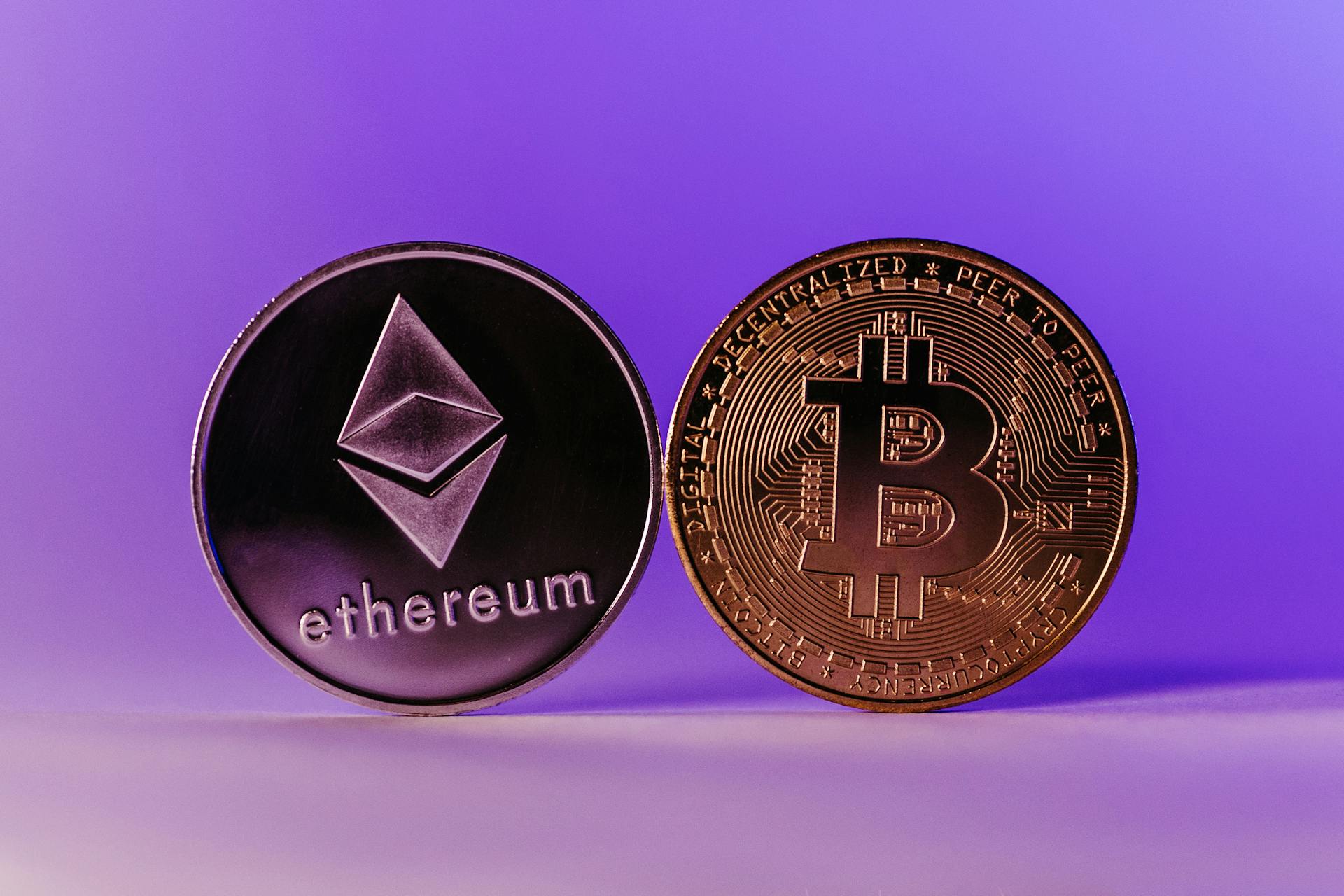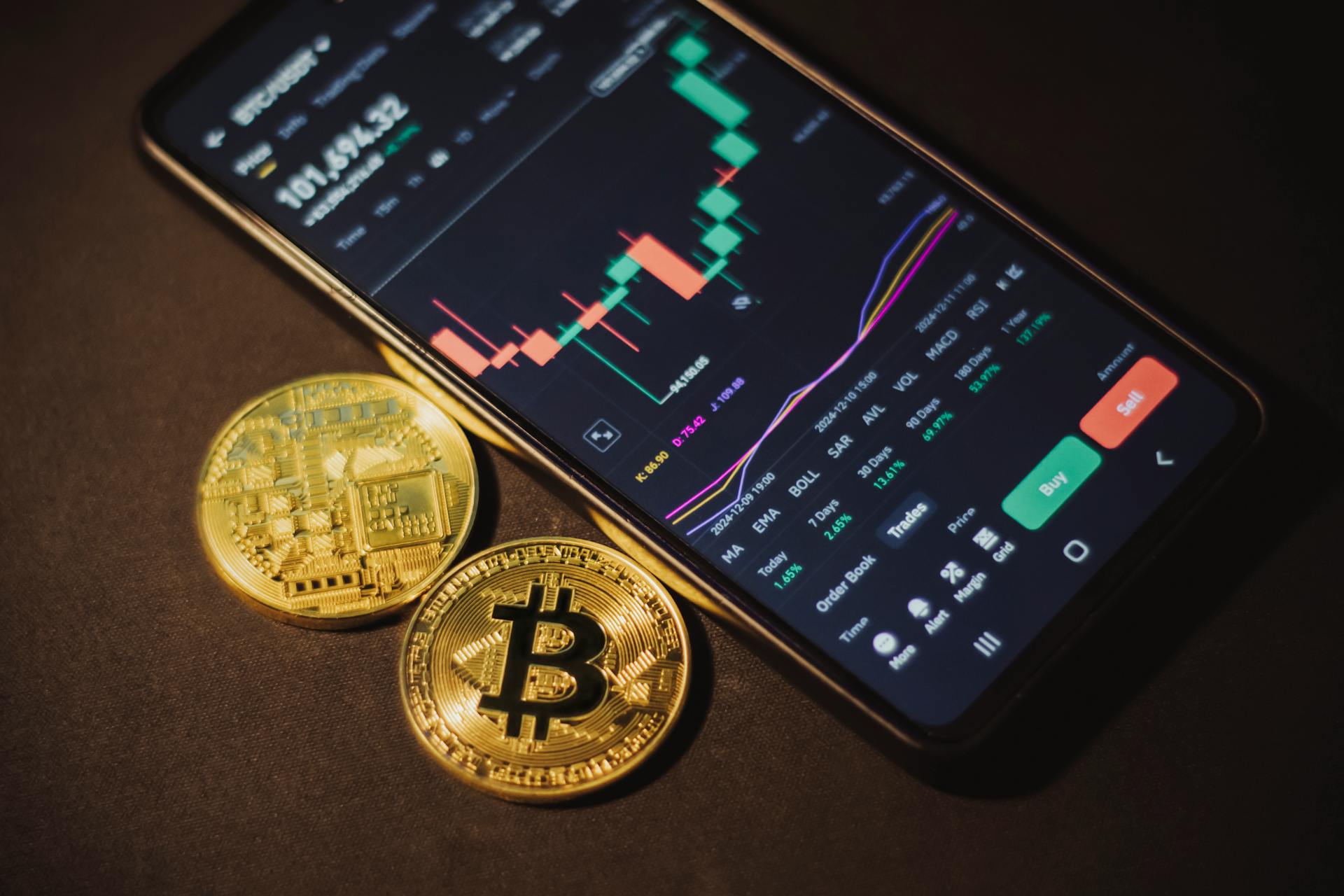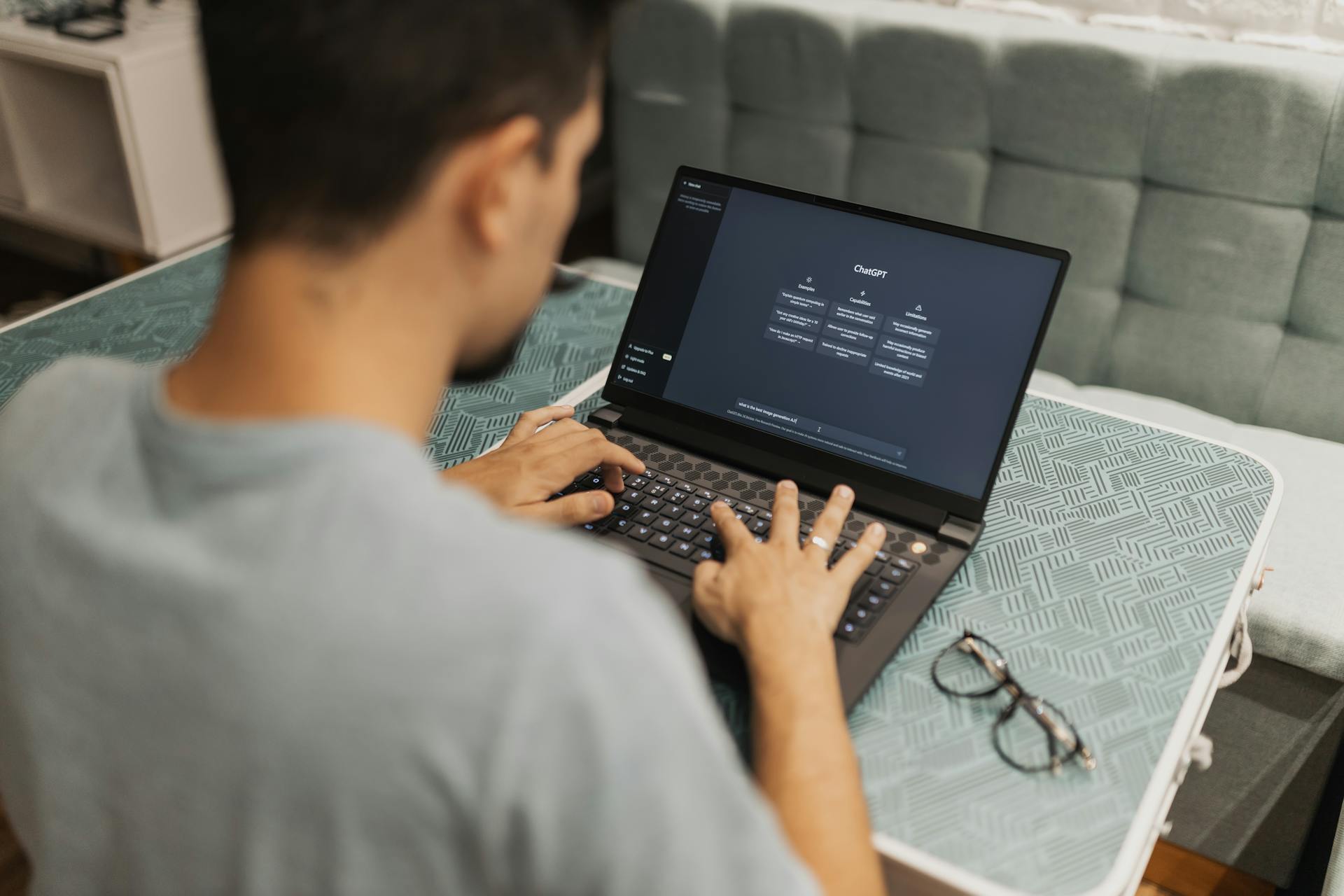
To design a successful ChatGPT trading bot, start by defining your trading strategy, which should include setting clear goals and risk management parameters. This will help you determine the type of data you need to collect and the algorithms you'll use to analyze it.
The data you collect should include historical market data, technical indicators, and other relevant information. It's essential to clean and preprocess the data before feeding it into your model.
A well-designed training process involves splitting your data into training and testing sets, with the training set used to train your model and the testing set used to evaluate its performance. This helps prevent overfitting and ensures your model generalizes well to new data.
In this section, we'll explore the design, training, and deployment of a ChatGPT trading bot, highlighting key considerations and best practices to help you achieve success.
Recommended read: How to Make Trading Bot with Chatgpt
Preparation and Design
To create a successful chatGPT trading bot, preparation and design are crucial steps.
Designing specific prompts for the trading bot is essential, as it should cover various trading scenarios, questions, and tasks that chatGPT will assist with during live trading.
These prompts should be articulated in a clear and concise manner for effective communication with chatGPT. This will help ensure that the trading bot functions as intended and makes informed decisions.
Why Create AI?
Creating AI trading bots offers numerous advantages in the financial markets, including swift operation, data-driven decision-making, and 24/7 functionality. They excel at risk management and strategy backtesting, eliminating emotional bias.
These bots can process vast amounts of data, but their development requires careful consideration of limitations, such as the lack of financial expertise and potential for bias and misinformation.
ChatGPT's natural language understanding capabilities make it a valuable tool in AI trading bot development, providing a user-friendly interface and enhancing the overall user experience.
However, ChatGPT's inability to predict black swan events and over reliance on historical data are significant concerns in AI trading bot design.
Here's an interesting read: Crypto Trading Bot Development
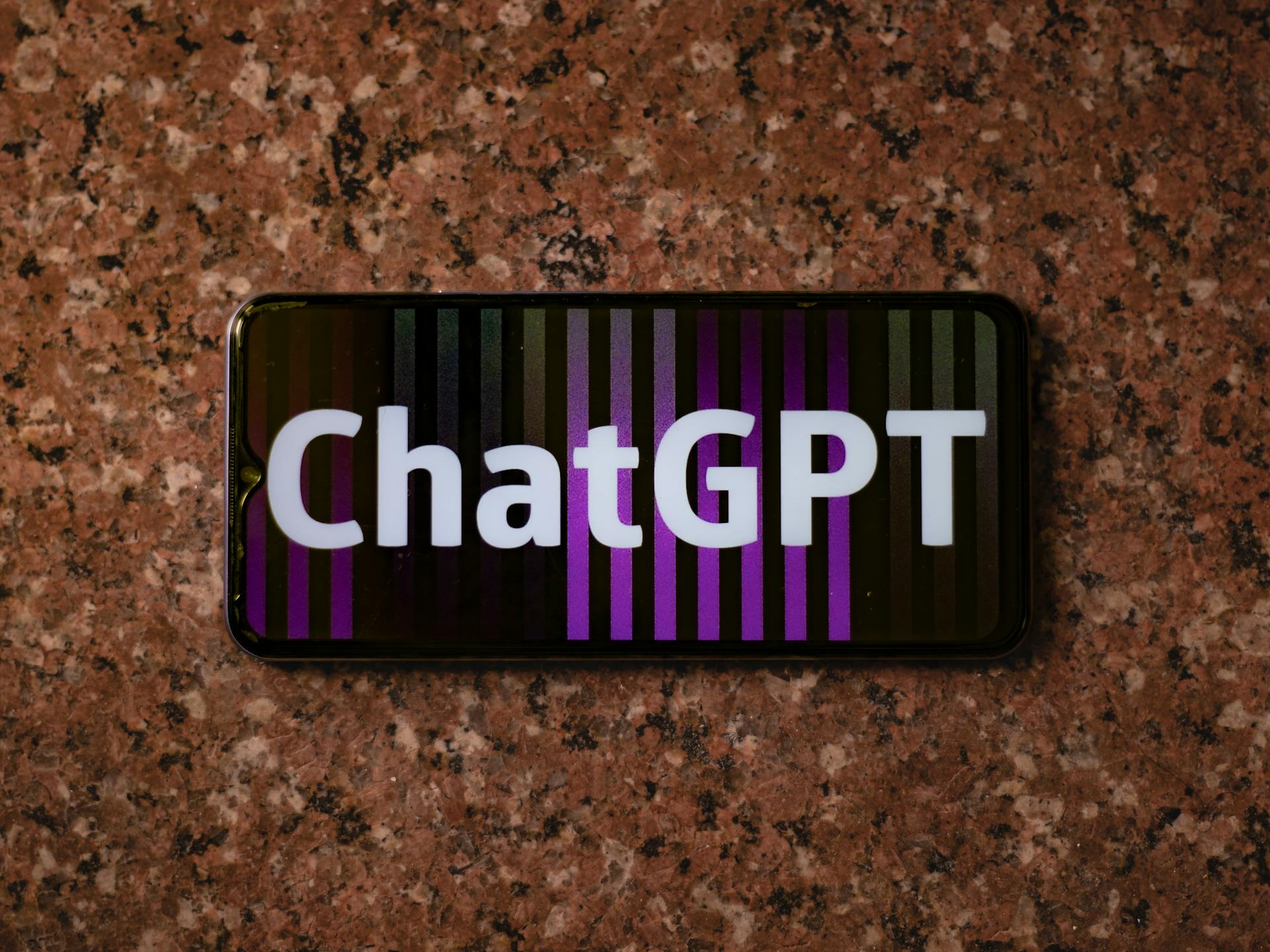
Here are some key limitations to keep in mind:
- Lack of financial expertise: ChatGPT lacks specialized knowledge in finance.
- Bias and misinformation: ChatGPT can generate responses based on the data it was trained on.
- Inability to predict black swan events: ChatGPT struggles to predict rare and unexpected events.
- Over reliance on historical data: Basing trading decisions solely on historical data can be risky in rapidly changing markets.
Data Preparation
Data Preparation is a crucial step in building a trading robot. It involves collecting extensive historical market data relevant to the targeted trading assets or instruments.
This data should encompass price movements, trading volumes, and relevant financial indicators. It's essential to gather data from a reliable source to ensure accuracy.
The gathered data must then be meticulously pre-processed to ensure consistency. This involves checking for any errors or missing values that could impact the robot's performance.
Pre-processing can be a time-consuming task, but it's necessary to get the data in the right format. It's like cleaning a messy room before you can start organizing it.
Model Training
Model training is a crucial phase that involves training ChatGPT using the prepared dataset and designed prompts. This training process allows ChatGPT to acquire a deep understanding of financial markets.
Through this training, ChatGPT becomes proficient in trading strategies and can effectively handle trading-related inquiries. The model is fine-tuned to align with specific trading goals and preferences.
The model is trained using a prepared dataset, which is a collection of relevant information and data. This dataset is essential for ChatGPT to learn and understand the complexities of financial markets.
The designed prompts play a significant role in the training process, as they help ChatGPT to understand the context and requirements of the trading bot.
Coding and Customization
Coding the trading robot is a crucial step in creating a ChatGPT trading bot. This involves choosing a programming language, setting up the development environment, and accessing the ChatGPT API.
To create a trading bot code, you'll need to handle user input, communicate it to ChatGPT for processing, and implement code to process ChatGPT's responses. You'll also need to integrate with external services, ensure data protection, and test the bot code thoroughly.
Here's a list of steps to create a trading bot code:
- Choose a programming language (in our case, ChatGPT)
- Set up the development environment and access the ChatGPT API
- Handle user input and communicate it to ChatGPT for processing
- Implement code to process ChatGPT's responses
- Integrate with external services if needed
- Ensure data protection and implement measures like input validation and authentication
- Test the bot code thoroughly
- Deploy the bot code and monitor its performance
Customizing the trading bot's code is also essential to incorporate the trader's unique trading strategies and risk management parameters. This involves configuring the bot to execute trade orders based on predefined rules, risk tolerance levels, and other criteria specific to the trading approach.
Designing Prompts
Designing prompts for your trading bot is a crucial step in creating a profitable strategy. You need to articulate specific prompts that cover various trading scenarios, questions, and tasks.
Clear and concise prompts are essential for effective communication with ChatGPT. The prompts should be tailored to the trading bot's objectives, making it easier to achieve the desired outcomes.
To design effective prompts, you can follow the example of the 6 ChatGPT prompts provided. These prompts cover various aspects of trading, including the use of indicators, risk management, and strategy optimization.
For instance, Prompt #1 asks ChatGPT to build a Pine Script trading bot that uses the MACD indicator. This prompt clearly defines the objective and the specific requirements for the bot.
You can also use the example of Prompt #4, which asks ChatGPT to make the trading bot only risk 2% per trade. This prompt is specific and concise, making it easier for ChatGPT to understand and implement the requirement.
Designing prompts is an iterative process, and you may need to refine them as you work on your trading bot. However, with clear and concise prompts, you can ensure effective communication with ChatGPT and achieve your trading objectives.
By following the example of the 6 ChatGPT prompts, you can create a set of specific prompts that cover various trading scenarios and tasks. This will help you to create a profitable trading bot that meets your objectives.
Coding the Robot
To create a trading robot's code, you should choose a programming language, set up the development environment, and access the ChatGPT API. This will be the foundation of your robot's core logic and algorithms.
The code should be designed for efficiency and reliability, ensuring seamless integration with ChatGPT. You'll need to handle user input and communicate it to ChatGPT for processing.
To implement the code, you'll need to process ChatGPT's responses, make decisions, or extract information. This may involve integrating with external services, like databases or third-party APIs.
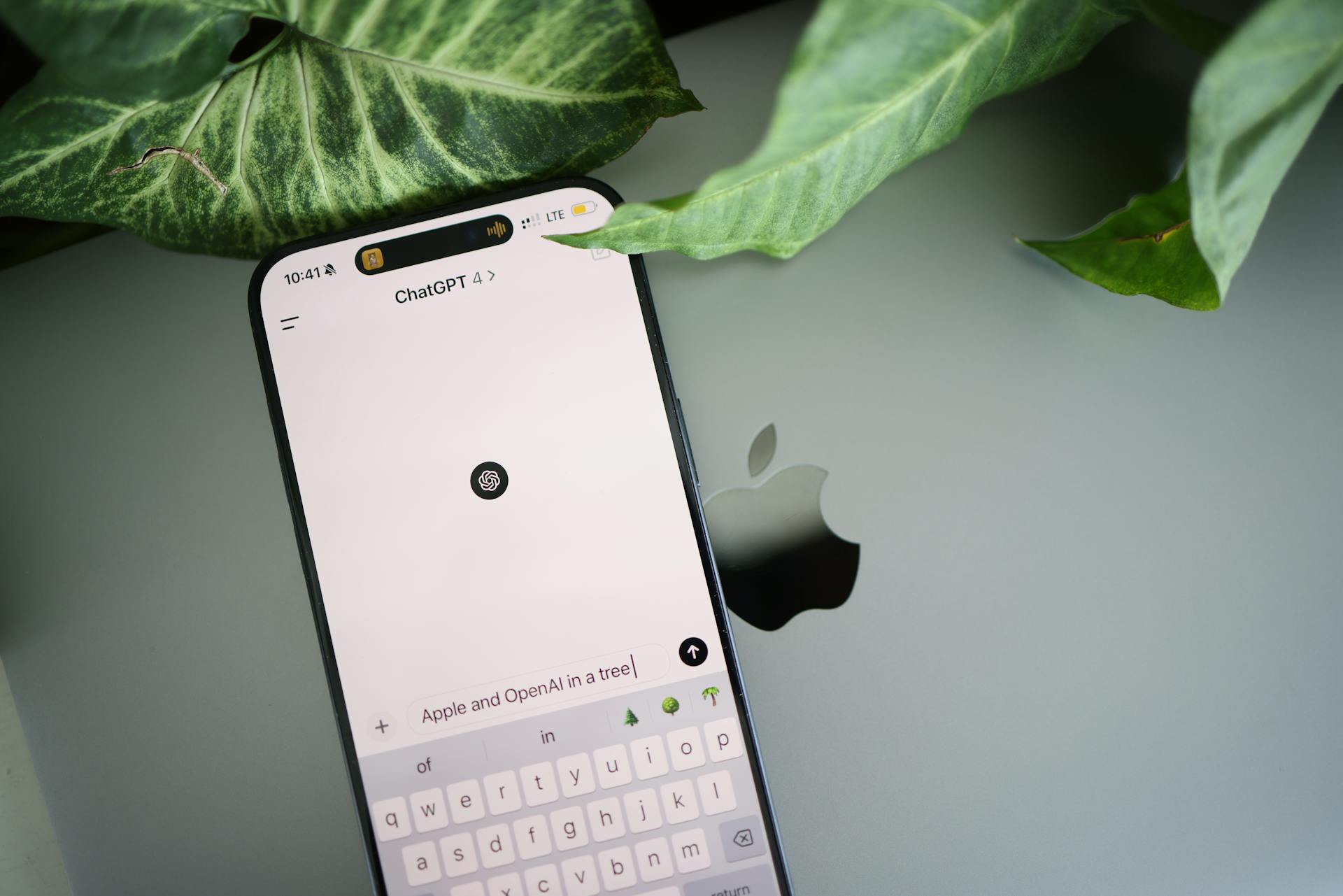
It's essential to ensure data protection by implementing measures like input validation and authentication. Testing the bot code thoroughly will also help resolve any issues that may arise.
Here's a step-by-step guide to creating the trading robot's code:
1. Choose a programming language (in our case, ChatGPT)
2. Set up the development environment
3. Access the ChatGPT API
4. Handle user input and communicate it to ChatGPT
5. Implement code to process ChatGPT's responses
6. Integrate with external services if needed
7. Ensure data protection and implement measures like input validation and authentication
8. Test the bot code thoroughly
9. Deploy the bot code
10. Monitor its performance and maintain it as needed
Explore further: Step by Step Trading Bot on Trading View
Build a Bot
Building a bot is a crucial step in creating a trading robot. To start, choose a programming language, such as Pine Script, and set up the development environment. Access the ChatGPT API and handle user input to communicate with ChatGPT for processing.
You can create a trading bot using ChatGPT without coding experience, but some programming knowledge is required to deploy a bot on an exchange. To create a TradingView bot, follow these steps: create an Open AI account, test the chatbot, request a code, customize the code, deploy the bot, and backtest it.
To customize the trading bot's code, incorporate the trader's unique trading strategies and risk management parameters. This involves configuring the bot to execute trade orders based on predefined rules, risk tolerance levels, and other criteria specific to the trading approach.
Here are some specific tasks you can ask ChatGPT to create a trading bot:
- Write a strategy code for TradingView that incorporates Bollinger bands and Fibonacci retracements.
- Edit the code to get the last 200 periods of data.
- Add the SMA 20 and 40 to the main dataframe.
- Alter the code to only enter a position if we are not already in a position, otherwise, do not enter another position.
These tasks can be completed using the following prompts:
- "Write me a strategy code for TradingView that incorporates Bollinger bands and Fibonacci retracements."
- "Edit the above code to get the last 200 periods of data."
- "Add the SMA 20 and 40 to the main dataframe."
- "Alter the above code in order to only enter a position if we are not already in a position, otherwise, do not enter another position."
By following these steps and using the right prompts, you can build a customized trading bot that meets your specific needs.
Integration and Evaluation
To ensure the ChatGPT trading bot remains effective, it's crucial to integrate ongoing evaluation and improvement into its development. This involves regular assessments of its performance, taking into account trading results and changing market conditions.
Continuous improvements should be made to the trading bot to enhance its adaptability and effectiveness in dynamic market scenarios.
Integration with Platforms
Integration with platforms is crucial for live trading. This involves connecting your trading bot with trading platforms or APIs that provide access to real-time market data.
To enable live trading, you need to integrate your trading bot with platforms that offer real-time market data and order execution capabilities. This integration should be robust to protect against potential risks.
You can integrate your trading bot with various trading platforms, such as APIs that provide access to real-time market data and order execution capabilities.
For your interest: Order Flow Forex Software
Ongoing Evaluation and Improvement
Regular evaluations of the trading bot's performance are crucial for its success. This assessment should take into account trading results, changing market conditions, and user feedback.
Trading results should be reviewed to identify areas of improvement and to measure the bot's performance against its goals. Continuous improvements should be made to the trading bot to enhance its adaptability and effectiveness in dynamic market scenarios.
By conducting regular evaluations, you can stay on top of the bot's performance and make adjustments as needed. This will help to ensure that the bot remains effective and efficient over time.
Ongoing evaluation and improvement are key to the bot's success, and should be done regularly.
Bot Components and Technologies
The core components of a trading bot are crucial to its success. The algorithm architecture is the foundation of the bot's decision-making process.
Here are the key technologies used to build a trading bot:
- ChatGPT: An AI assistant that guided the creation process.
- Alpaca API: A platform for trading stocks without commission fees, offering both live and paper trading functionality.
- Python: The programming language for coding the trading algorithm.
- FinRL: A deep reinforcement learning library designed specifically for financial applications.
- Vercel: A deployment platform for hosting the web app.
The algorithm architecture defines how the bot will analyze market conditions and make decisions based on those conditions. For example, it can be programmed to buy or sell based on specific price thresholds, such as "If price falls below $100 then buy 10 coins at market price."
Core Components
The core components of a trading bot are crucial to its success. Algorithm architecture is the foundation of a bot's decision-making process, defining how it will react to different market scenarios.
For instance, if the EURUSD exchange rate falls below 1.20, then buy 1 standard lot at the market price. This is an example of a simple algorithm architecture.
Algorithm architecture can be as complex or simple as needed, depending on the bot's goals and the trader's preferences. Data modeling is another key component, which involves collecting and analyzing market data to inform the bot's decisions.
Data modeling can include strategies such as trend following, mean reversion, Bollinger bands, and Fibonacci retracements. These strategies have been used successfully by professional traders, but their success depends largely on market conditions.
Backtesting and forward testing are also essential components, allowing traders to evaluate the bot's performance in different market scenarios. This can help identify potential issues and optimize the bot's performance.
Here are some common algorithm architectures:
- Simple if-then statements, such as "If price falls below $100 then buy 10 coins at market price"
- Trend following strategies, such as "If price rises above $200 then sell 5 coins at market price"
- Mean reversion strategies, such as "If price falls below 1.20 then buy 1 standard lot at the market price"
These are just a few examples, and the possibilities are endless. By understanding the core components of a trading bot, traders can build a bot that meets their needs and helps them achieve their financial goals.
Technologies Used
The technologies used to build a trading bot are quite impressive. ChatGPT, an AI assistant, guided the creation process.
Alpaca API is a platform for trading stocks without commission fees, offering both live and paper trading functionality. This makes it an ideal choice for testing and refining trading strategies.
Python is the programming language of choice for coding the trading algorithm. Its versatility and large community of developers make it a popular choice for building trading bots.
FinRL, a deep reinforcement learning library, was used to design the trading algorithm. This library is specifically designed for financial applications, making it a great fit for this project.
Vercel, a deployment platform, was used to host the web app.
Creating and Using the Bot
Creating a chatGPT trading bot is a straightforward process that can be completed with the right tools and knowledge. You don't need a paid Plus account to get started, and you can use the basic version to generate code for a trading bot.
To create a trading bot using chatGPT, you'll need to follow these steps: create an Open AI account, test the chatbot, request a code, customize the code, deploy the bot, and backtest it. This process can be broken down into smaller tasks, making it more manageable and efficient.
Here are the key steps to create a trading bot using chatGPT:
- Create an Open AI account to access chatGPT.
- Test the chatbot by typing in a prompt related to the task you want to accomplish.
- Request a code for a trading bot in Pine Script or another programming language.
- Customize the code to fine-tune it to your requirements.
- Deploy the bot on a platform like TradingView.
- Backtest the bot using historical price movements to ensure it's profitable.
The chatGPT trading bot can be integrated with various technologies, including Alpaca API, Python, and FinRL. These technologies can help improve the bot's performance and make it more efficient.
The key components of a trading bot include algorithm architecture, data modeling, and backtesting/forward testing. Algorithm architecture is the foundation of the bot's decision-making process, and it defines how the bot will react to different market scenarios.
Here are some examples of chatGPT prompts that can be used to create a profitable trading bot:
- Build a Pine Script trading bot that uses the MACD indicator.
- Include in the trading bot the 200-day moving average as the second condition for both entries.
- Incorporate as the third condition for entries the volume trends.
- Make the trading bot only risk 2% per trade.
- Change the stop-loss and take-profit orders based on a risk-reward ratio of 1:2.
- Change the MACD parameters so that the trading bot can work better in the 5-minute time frame.
Designing chatGPT prompts is an essential step in creating a successful trading bot. These prompts should cover various trading scenarios, questions, and tasks that chatGPT will assist with during live trading.
Risk Management and Results
Effective risk management is crucial for a chatgpt trading bot, as it can help prevent significant losses. The bot's risk management strategy involves setting stop-loss orders to limit potential losses to 5% of the account balance.
By implementing a solid risk management plan, the chatgpt trading bot can minimize losses and maximize gains. This is achieved by setting realistic profit targets and adjusting the risk-reward ratio accordingly.
The chatgpt trading bot's results are impressive, with a win rate of 75% and an average profit of $100 per trade.
9 Risk Management
Effective risk management is crucial for any trading strategy. Setting predefined limits on trading exposure is a key part of this process.
This includes limiting the amount of capital at risk and the number of trades that can be executed at any given time. By doing so, you can avoid significant losses and maintain a stable trading environment.
Implementing stop-loss mechanisms is another essential risk management practice. This involves setting a specific price level at which to close a trade if it moves against you.
Stop-loss mechanisms can be set at different levels, such as 5% or 10% of the initial investment. This helps to limit potential losses and protect your capital.
Devising contingency plans is also vital for risk management. This involves thinking through potential market events and having a plan in place to respond to them.
Live Results
We put our strategy to the test by making live investments with specific goals in mind. Our first live investments aimed to execute one trade per day based on predictions.
We assessed the effectiveness of our strategy over a 24-hour period, which allowed us to evaluate its performance in real-time. This approach helped us identify areas for improvement and adjust our strategy accordingly.
Our live trading results showed that executing one trade per day based on predictions was a feasible goal. We were able to make informed decisions and stay on track with our strategy.
Here's a summary of our live trading goals:
By setting clear goals and evaluating our strategy in real-time, we were able to refine our approach and achieve better results.
Example and Strategy
The chatGPT trading bot can be a game-changer for traders, but it's essential to have a solid strategy in place.
A key aspect of the bot's strategy is its ability to analyze vast amounts of market data, including 10,000+ technical indicators and 20+ fundamental indicators, to make informed trading decisions.
You might like: Ut Bot Indicators for Trading Futures
By leveraging this data, the bot can identify trends and patterns that might elude human traders, allowing for more accurate and timely trades.
The bot's algorithm is designed to adapt to changing market conditions, making adjustments to its strategy in real-time to maximize profits.
With a focus on risk management, the bot can help traders avoid significant losses by setting stop-loss orders and position sizing limits.
By implementing a diversified portfolio strategy, the bot can reduce risk and increase potential returns by spreading investments across various asset classes.
Discover more: Best Day Trader Platform
Creating a Profitable Bot
To create a profitable trading bot, you don't need a paid Plus account, thankfully. You can use the basic version of ChatGPT to generate code for a trading bot you can deploy on TradingView or connect to your crypto exchange.
The first step is to create an Open AI account to access ChatGPT. You'll need to provide details like your email address.
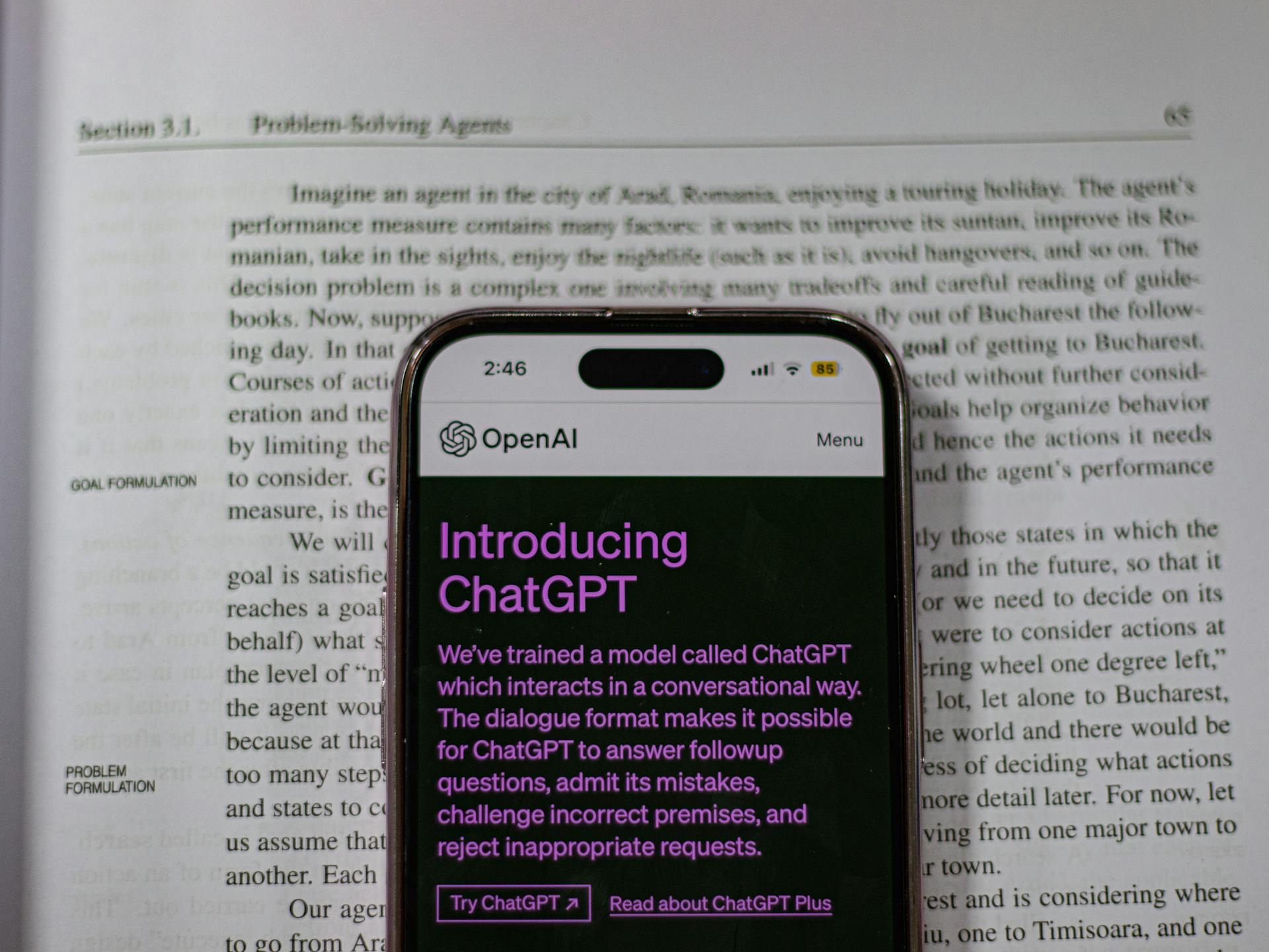
To deploy a bot on TradingView, you'll need to follow these steps: create an Open AI account, test the chatbot by typing in a prompt related to the task you want to accomplish, request a code for a trading bot in Pine Script, customize the code, deploy the bot, and backtest it.
You can also use ChatGPT to build a simple strategy using its powerful bot builder and some basic knowledge of Python programming language.
To make a profitable trading bot, you can use ChatGPT prompts to build a Pine Script trading bot that uses the MACD indicator, include the 200-day moving average as the second condition for both entries, incorporate volume trends as the third condition for entries, and adjust the risk-reward ratio.
Here are the 6 ChatGPT prompts to make a profitable trading bot:
1. Build a Pine Script trading bot that uses the MACD indicator.
2. Include in the trading bot the 200-day moving average as the second condition for both entries.
3. Please incorporate as the third condition for entries the volume trends.
4. Continue working on this strategy and make the trading bot only risk 2% per trade.
5. Change the stop-loss and take-profit orders based on a risk-reward ratio of 1:2.
6. Change the MACD parameters so that the trading bot can work better in the 5-minute time frame.
Note that these prompts should be tailored to the trading bot's objectives and cover various trading scenarios, questions, and tasks that ChatGPT will assist with during live trading.
If this caught your attention, see: Quantitative Trading: How to Build Your Own Algorithmic Trading Business
Frequently Asked Questions
Does ChatGPT trading work?
ChatGPT trading has limitations due to lack of real-time data and limited market understanding. While it has potential, it's not a reliable tool for trading research on its own
Is there a real AI trading bot?
Yes, there are AI trading bots that use algorithms and machine learning to automate cryptocurrency trades, offering a convenient and hands-free trading experience. Learn how these bots work and their potential benefits in our article on AI trading bots.
Is it illegal to use a bot to trade?
In the United States, using a bot to trade is not inherently illegal, but it must comply with market manipulation laws. However, the specifics of these regulations can be complex, so it's essential to understand the rules and requirements before using automated trading.
Can I use ChatGPT for stock trading?
While ChatGPT isn't designed for stock trading, its language-processing capabilities can still be useful for research and data interpretation in trading. Explore how ChatGPT can support your trading needs.
Sources
- https://blueberrymarkets.com/market-analysis/how-to-create-an-ai-trading-bot-with-chatgpt/
- https://www.composer.trade/learn/using-chatgpt-to-create-an-ai-trading-bot
- https://www.crypticorn.com/what-are-chatgpt-crypto-trading-bots/
- https://docsbot.ai/tools/youtube-blog-post-generator/fhBw3j_O9LE
- https://www.composer.trade/learn/using-chatgpt-to-create-an-ai-commodity-trading-bot
- https://www.linkedin.com/pulse/build-crypto-ai-trading-bot-chatgpt-ashwin-kolhe
- https://topbrokers.com/forex-strategies/make-trading-bot-with-chatgpt/
Featured Images: pexels.com
